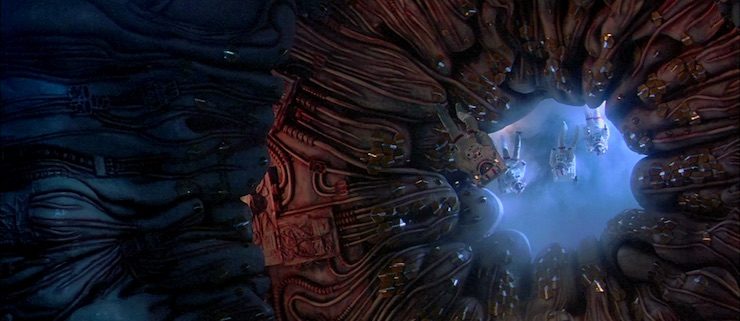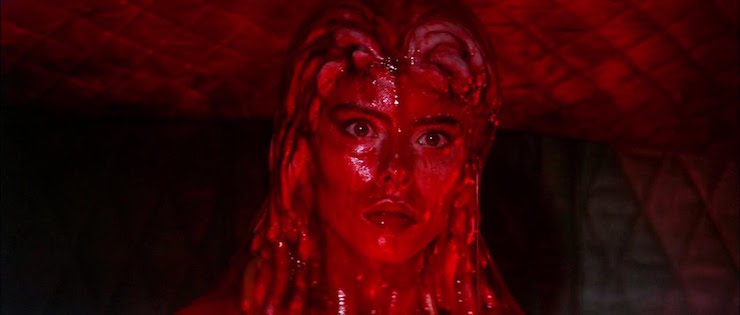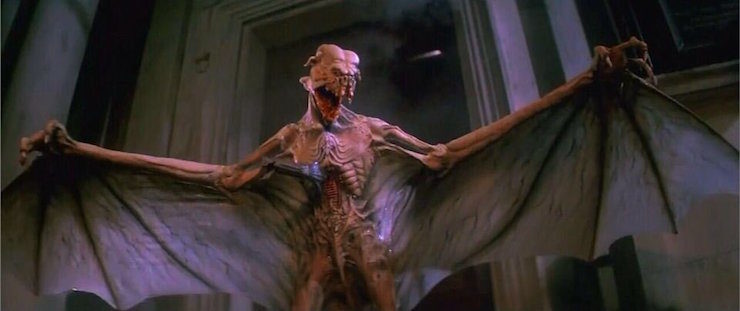Another horror veteran, Tobe Hooper, passed away over the weekend. Hooper is best known for the original Texas Chainsaw Massacre and Poltergeist, and for good reason: in entirely different ways, those two movies have done as much to influence contemporary horror cinema as the equally great, equally missed, George A. Romero’s body of work. Texas Chainsaw Massacre pioneered the true age of gore (and implied gore) in horror and remains an acknowledged classic. Poltergeist set the template for suburban family in peril stories that would echo down the decades and become instrumental in the eventual success of the Blumhouse model (the company behind the Paranormal Activity and Purge movies, as well as Get Out).
My favourite example of Hooper’s work, however, is 1985’s Lifeforce—and I can think of no better way to celebrate his legacy than taking another look at the film.
For those of you who’ve not seen it, Lifeforce is based on the novel The Space Vampires by Colin Wilson, with a screenplay by Dan O’Bannon (of Alien fame) and Don Jakoby. It opens with the crew of the space shuttle Churchill, on a joint US/UK mission to Halley’s Comet, discovering a 150 km long spaceship hiding in the comet’s tail. They board the vessel and discover thousands of desiccated husks of bat-like aliens….and three perfectly preserved corpses. All naked. All human.
A month later, the Churchhill drifts back into Earth’s orbit. The crew are all dead due to an internal fire, the escape pod is missing, and only the corpses remain…

So to be clear, the first 20 minutes the film:
- Assumes a level of technical development/proficiency and international cooperation that’s both hopelessly advanced and rather sweet.
- Assumes that a space shuttle could House a crew of around a dozen on a months-long round trip through interplanetary space.
- Assumes that diving into the tail of a comet would be something a crewed ship could be designed to do.
And of course:
- There are naked alien space vampires.
In other words, Lifeforce sets the tone early and runs headlong at it with an iron sword in one hand and a service pistol in the other. Because, to the surprise of no one, those “corpses”? Not so dead. Or, to put it in B-movie terms (and believe me, this is such a B-movie): NAKED ALIEN SEX VAMPIRES WALK THE EARTH.
That premise by itself would make for some good schlocky fun, and the film has plenty of that: apparitions made of blood, desiccated corpses screaming as they explode into dust, and one character giving a helpful info dump just before his soul is blown out of his back are just a few of the sights Lifeforce has to show you. This is Hooper not as well-behaved horror surgeon but as the ring master of a circus of spectacle. A deadly naked alien lady! An astronaut tormented by his lust! London in ruins! Halley’s Comet as a harbinger of very real disaster! The film escalates so well, starting with the Churchill sequence and pinballing around every horror sub-genre it can. There’s elements of an outbreak narrative here, alongside alien invasion, alongside historical plague, alongside apocalyptic end-of-the-world stories. Hooper keeps changing the channel on the viewer all the time, dragging us along with him in a two-hour sprint through modern horror’s favorite nightmares.

…Not to mention some of society’s own not-so-secret terrors and neuroses at the time. There are entire theses to be written about the movie’s terror of female sexual authority and the female body as expressed through Mathilda May’s almost-silent space vampire queen. Likewise, the clear homoeroticism in the way all three vampires’ predatory habits are portrayed, as when an eyewitness doubles back to watch the female vampire and a female victim in case they were “…doing something.” This is very much a film of its time, simultaneously fascinated and horrified by homosexuality; the movie seems to view sexuality itself as something alien and feral, to be studied at one remove by stern-looking academics and soldiers in polo necks and pocket watches. In other words, none more 80s, and none more British 80s.
Looking back from the present moment, Lifeforce functions now as a snapshot of a period of history, and sometimes that snapshot does not show us things that are comfortable. That sense is never starker than during a brief side trip to an asylum where the interrogation of a former vampire host with a masochism fetish is used as an excuse for some low level T-and-A, violence, and an info dump. Minutes later, the same sequence presents the prospect of two men kissing as the height of personal terror for one of our protagonists. As a historical cultural artefact, this is fascinating stuff but it’s also hard to watch at times. At its worst, Lifeforce is a mean-spirited embodiment and implied celebration of the worst elements of pre-millennial English culture. The prejudices of the class system are rampant, women’s roles are limited to sex objects, victims, or whores, and everyone in power is automatically assumed to be trustworthy even if, and when, they are patently shown not to be.
So…is it any good?
No, it’s like someone stitched schlock horror together with John Wyndham-esque sci-fi and Doctor Who.
And yes, because it’s like someone stitched schlock horror together with John Wyndham-esque sci-fi and Doctor Who!
Three elements hold the movie together. The first is Hooper’s direction and visual style. The film gleefully borrows from the design aesthetic of Alien (which makes sense, given that Dan O’Bannon co-wrote the screenplay), Doctor Who, Invasion of the Body Snatchers, and British TV to create something very odd out of familiar elements. At one point the female vampire attacks someone who is dressed like an extra from Emmerdale Farm. At another, the lead characters witness just how widespread the vampire plague is in the middle of what could be a set from Yes Minister. At another still, a big Hero moment takes places in a resolutely dull, boxy 1980s car. The story becomes as much an invasive force as the vampires—this resolutely big, spectacular, Hollywood-style story playing out in a country whose televisual landscape was still largely costume dramas, quarries, and hard-hit inner cities. It’s a weird, fun, antagonistic mix and it gives even the film’s most ridiculous moments energy even now.

Then there’s the cast.
Well…some of the cast.
Steve Railsback and Mathilda May are both front and center and the film’s weakest links. Railsback plays Carlsen, the Churchill’s commanding officer and the yell-happy Renfield to May’s Space Dracula. He has one gear throughout the movie: agonized shouting with an occasional downshift to agonize snarling. Carlsen is less a character than a walking plot device and is hard to like at the best of times. Likewise, May is required to do functionally nothing other than be naked and stare at people. Had the film’s main antagonist been given anything to work with as a character, the obviously exploitational nature of her role would be offset. As it stands? Naked Alien Space Vampire McGuffins walk the Earth.
But don’t worry, because Colonel Colin Caine of the SAS is here and he is done with ALL of this! Peter Firth, in an early leading role, is almost implausibly good fun. Caine is relentlessly stoic, more than slightly grumpy, and has no patience at all for the fantastical elements of the story. That means Caine is exactly the hero this movie desperately needs. He’s utterly British, ego-less, and has a refreshingly direct approach to problem solving; he’s laconic and funny without being showy, and plays for all the world like an unusually violent incarnation of the Doctor, or Captain Jack Harkness with a hangover. Firth is so much fun here, in fact, that when Spooks (MI-5 on the other side of the Atlantic) started, I instinctively viewed his character there as Colonel Caine under a code name.
The rest of the cast is patchy, but Frank Finlay is great fun as Doctor Hans Fallada, the only rocket scientist to have a vampire-murdering iron sword in his office. Elsewhere, Sir Patrick Stewart has a fun turn as the head of an asylum. But trust me: this is Colonel Caine’s movie all the way down.

That ties back to the final reason the film still works: the sources that it borrows from and the later shows and movies that have borrowed, in turn, from it. Vast tracts of it seem to be directly channeling sources like ITV’s Quatermass, a Romero movie, a Body Snatchers-alike, or Doctor Who. Perhaps most of all, it feels like an odd predecessor to Torchwood: the collision between sex and horror, the taciturn, hyper-competent, and trenchcoated lead, the secret government facilities… You can draw a straight line between some or all of these elements and Torchwood, or The Last Train, or Primeval. Lifeforce borrows a colossal amount from its sci-fi predecessors, but it re-defines what it borrows and helps set a blueprint for some of the most influential genre shows and movies that would follow it. The movie is uneven, has aged extremely badly in several key places, and embodies the absolute worst of its time as well as the best—but it’s sunk deep into the DNA of TV and cinema genre fiction on this side of the Atlantic and without it, we wouldn’t have gotten some of the classics that followed its release.
It seems eminently appropriate to me that Lifeforce should, like the mysterious spaceship that drives its plot, be hiding in plain sight. Just as influential in its way, just as important as Poltergeist and Texas Chainsaw Massacre, it’s often overlooked in their favour. It’s far from perfect, massively dated, but just as fascinating as these other films, generally considered horror classics. And, for me, it’s the height of Tobe Hooper’s career. Somewhere, Colonel Colin Caine is raising a glass to his director. I am too. Thank you, sir.
Alasdair Stuart is a freelancer writer, RPG writer and podcaster. He owns Escape Artists, who publish the short fiction podcasts Escape Pod, Pseudopod, Podcastle, Cast of Wonders, and the magazine Mothership Zeta. He blogs enthusiastically about pop culture, cooking and exercise at Alasdairstuart.com, and tweets @AlasdairStuart.










